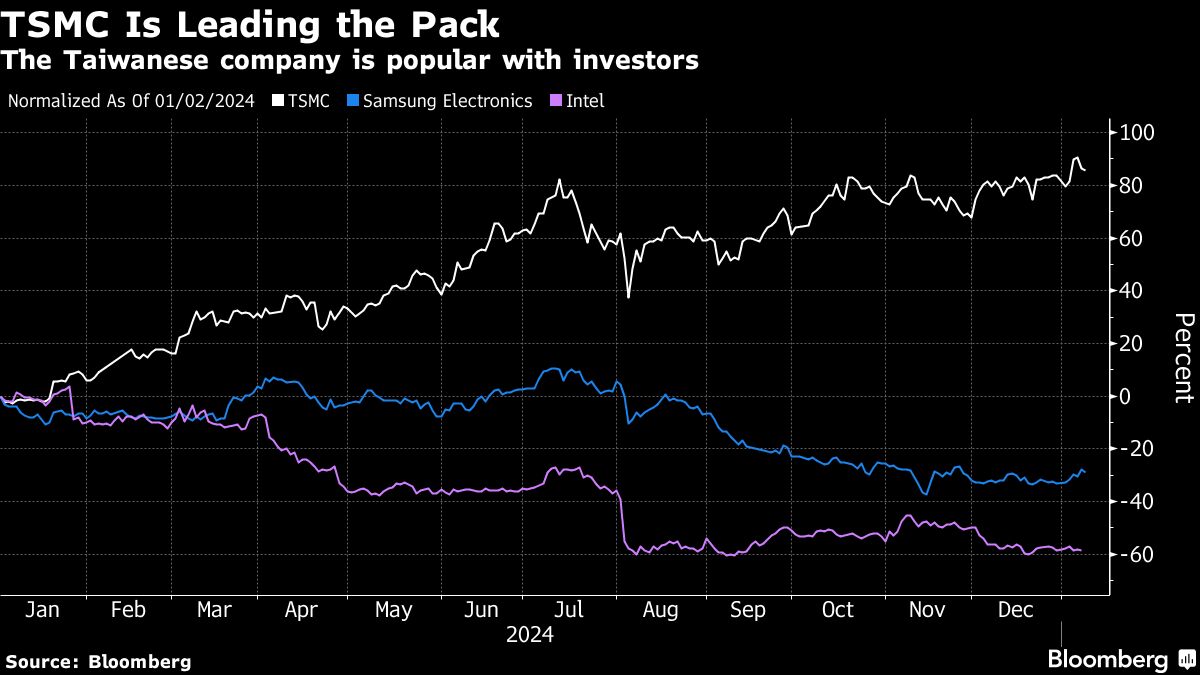(Bloomberg) — Taiwan Semiconductor Manufacturing Co.’s quarterly sales topped estimates, reinforcing investor hopes that the torrid pace of AI hardware spending will extend into 2025.
Most Read from Bloomberg
The go-to chipmaker for Nvidia Corp. and Apple Inc. reported a 39% rise in October-December revenue to NT$868.5 billion ($26.3 billion), based on calculations off monthly disclosures. That compares with an average estimate of NT$854.7 billion.
The strong showing from Taiwan’s largest company bolsters expectations that big tech companies from Alphabet Inc. to Microsoft Corp. will continue to build and upgrade datacenters at a rapid clip to propel AI development. This month, AI server maker Hon Hai Precision Industry Co. reported better-than-expected sales, while Microsoft outlined plans to spend $80 billion this fiscal year on datacenters.
The world’s largest maker of advanced chips has been one of the biggest beneficiaries of a global race to develop artificial intelligence. Its shares have more than doubled since that boom took off in late 2022 with the debut of OpenAI’s ChatGPT. TSMC’s market capitalization briefly crossed the $1 trillion mark in the US.
Yet more bearish market observers point to potential over-building, bottlenecks to development such as power shortages, and the persistent absence of a killer AI app or service that will use up all that server capacity.
Beyond Nvidia and the AI arena, the Taiwanese company, which will report full results on Thursday, must grapple with mounting tech market and geopolitical uncertainties in 2025.
What Bloomberg Intelligence Says
The company’s gross margin is likely to expand to a two-year high of 58%, or more. On the upcoming earnings call, four areas merit attention: First, the outlook for CoWoS advanced-packaging capacity build and revenue, which is likely to give insight into the expected strength for AI chip demand in the coming 12-18 months. Second, progress on the US Arizona fab’s ramp-up, which is critical to meeting the onshoring chipmaking needs of Apple, Nvidia and others. Third, potential margin pressure from weaker demand in 7-, 16-nm and larger mature nodes.
Finally, capital-spending plans for 2025, which will signal TSMC’s confidence in the uptake of its next-generation N2 node.
– Charles Shum, analyst
Click here for the research.
TSMC remains reliant on Apple’s business, as the main producer of chips for the iPhone. The US company is struggling to galvanize demand for its marquee product in 2025, though many users hope that the gradual addition of AI features will drive the gadget’s next iteration.
The US has also erected a web of restrictions to curtail the flow of Nvidia’s most powerful chips to China, with uncertain longer-term ramifications for TSMC’s key customer.
Morgan Stanley expects TSMC’s first-quarter revenue to decline 5% sequentially due to iPhone seasonality. It expects TSMC to project annual sales growth of low-20% in dollar terms. “TSMC usually guides conservatively at the beginning of the year, and then over-delivers,” analyst Charlie Chan wrote.
Longer-term, TSMC is pursuing a rapid international expansion. It foresees capital expenditure rising in 2025 from roughly $30 billion this year.
It’s planning more plants in Europe with a focus on the market for artificial intelligence chips, according to a senior Taiwanese official. That’s on top of construction underway in Japan, Arizona and Germany.
Most Read from Bloomberg Businessweek
©2025 Bloomberg L.P.
Source link
